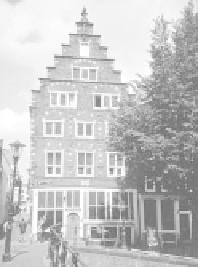Travel Reference
In-Depth Information
Brussels sells waffles and beer to passing travelers. Politically, the
Low Countries are united through marriage with the cultured
empire of the Dukes of Burgundy.
Sights
• Churches: Amsterdam's Old Church (Oude Kerk) and New
Church (Nieuwe Kerk), and Haarlem's
Grote Kerk
• Amsterdam's Waag (in the Red Light
District), the Mint Tower from the
original city wall, and the wooden house
at Begijnhof 34
• Bruges' bell tower, the Gothic Room in
the City Hall, and the Church of Our
Lady
• Flemish Primitive art (Van Eyck,
Memling, Van der Weyden) in Bruges'
Groeninge and Memling museums, and
in Brussels' Royal Museums of Fine
Arts of Belgium
• Brussels' Grand Place, medieval street Rue des Bouchers
(Restaurant Row), and Notre-Dame du
Sablon Church
1500s—Protestants vs. Catholics, Freedom-
Fighters vs. Spanish Rulers
Protestantism spreads through the Low Countries, particularly in
Holland (while Belgium remains more Catholic). Thanks to other
royal marriages, the Low Countries are
ruled from afar by the very Catholic
Habsburg family in Spain. In 1566,
angry Protestants rise up against Spain
and Catholicism, vandalizing Catholic
churches and deposing Spanish gov-
ernors. King Philip II of Spain sends
troops to restore order and brutally
punish the rebel-heretics, beginning
the Eighty Years' War, also known
as the Dutch War of Independence
(1568-1648).
Sights
• Amsterdam's whitewashed, simply decorated, post-Iconoclasm
churches
• Civic Guard portraits in Amsterdam History Museum
• Mementos of the Siege of Haarlem in Haarlem's Grote Kerk
• Brussels' tapestry designs





















